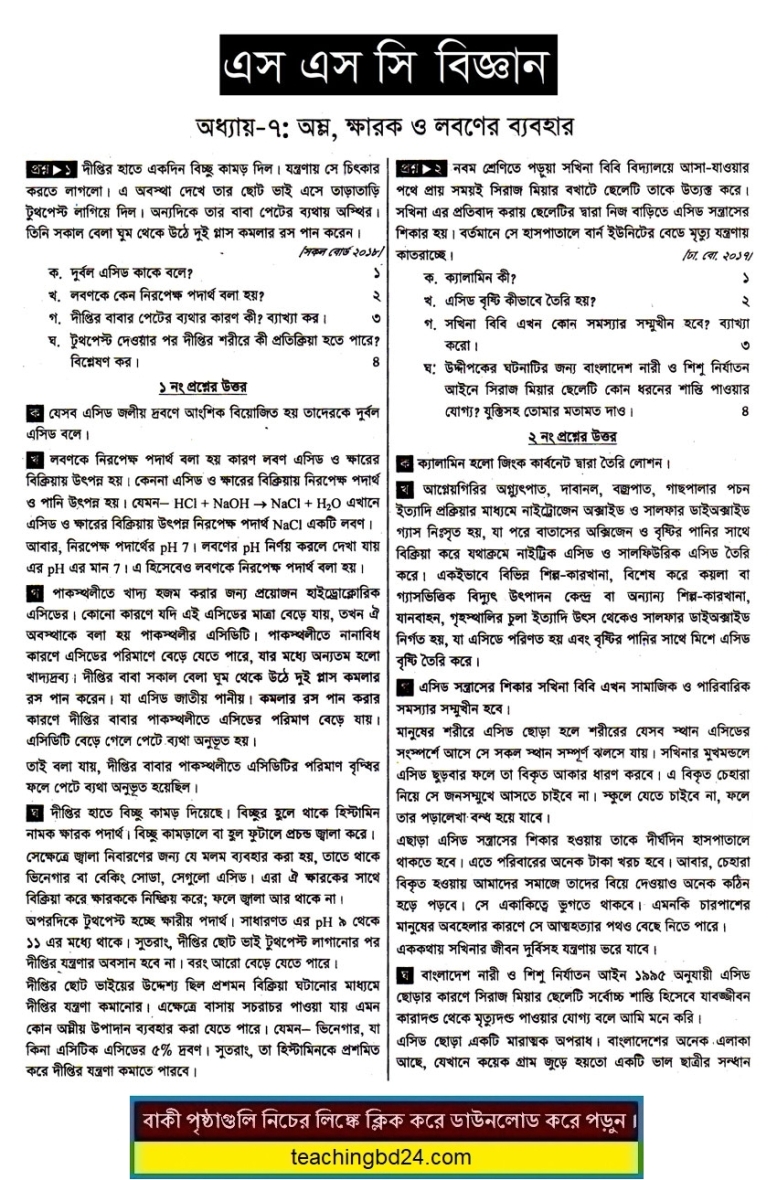Chapter 7. Use of Acid, Base, and Salt
Chapter 7. Use of Acid, Base, and Salt. SSC MCQ Question Ans. Use of Acid, Base, and Salt. Introduction: You have learned about acid, base, and salt in class VIII. Can you remember their characteristics? In this chapter, we shall discuss different uses of acid, base, and salt.
You have learned about some organic acids in class VIII. You also know that acids produce hydrogen ion (H+) in water. There are some acids, particularly organic acids, which do not dissociate completely in water, i.e. they dissociate partially which means all the acid molecules present do not produce H+ ion. These acids are called weak acids. On the other hand, mineral acids completely dissociate in water to produce H+ i.e. all the acid molecules present undergo dissociation.
Do you know the reason for irritation and swelling when wasps or scorpion sting? It is due to the fact that, when they sting us, a base named histamine is released and this histamine is responsible for irritation and swelling. To treat the sting, the paste used contains vinegar and baking soda which are acids. They react with the base (histamine) and neutralize it; therefore, pain, irritation, and swelling reduce.
Chapter 7. Use of Acid, Base, and Salt


Salt, in chemistry, substance produced by the reaction of an acid with a base. A salt consists of the positive ion (cation) of an acid and the negative ion (anion) of a base. The reaction between an acid and a base is called a neutralization reaction.
Salt, in chemistry, substance produced by the reaction of an acid with a base. A salt consists of the positive ion (cation) of an acid and the negative ion (anion) of a base. The reaction between an acid and a base is called a neutralization reaction. The term salt is also used to refer specifically to common table salt, or sodium chloride. When in solution or the molten state, most salts are completely dissociated into negatively and positively charged ions and are good electrolytes (conductors of electricity).
In acid-base chemistry, a salt is defined as the ionic compound that results from a neutralization reaction between an acid and a base. As such, salts are composed of cations (positively charged ions ) and anions (negative ions), and in their unsolved, solid forms, they are electrically neutral (without a net charge). The component ions in salt can be inorganic; examples include chloride (Cl−), the organic acetate (CH3COO−), and monatomic fluoride (F−), as well as polyatomic ions such as sulfate (SO42−).
Keep in mind that salt will only be basic if it contains the conjugate base of a weak acid. Sodium chloride, for instance, contains chloride (Cl–), which is the conjugate base of HCl. But because HCl is a strong acid, the Cl– ion is not basic in solution, and it isn’t capable of deprotonating water.
When dissolved in water, acidic salts will yield solutions with a pH of less than 7.0. This is due either to the presence of a metal cation that acts as a Lewis acid (which will be discussed in a later concept), or, quite commonly, due to a hydrolyzable proton in the cation or the anion. Salts with acidic protons in the cation are most commonly ammonium salts or organic compounds that contain a protonated amine group. Examples include:
ammonium (NH4+)
methyl ammonium (CH3NH3+)
ethyl ammonium (CH3CH2NH3+)
anilinium (C6H6NH2+)
An example of an acid salt is one containing any of these cations with a neutral base, such as ammonium chloride (NH4Cl).
teachingbd24.com is such a website where you would get all kinds of necessary information regarding educational notes, suggestions and questions’ patterns of school, college, and madrasahs. Particularly you will get here special notes of physics that will be immensely useful to both students and teachers. The builder of the website is Mr. Md. Shah Jamal Who has been serving for 30 years as an Asst. Professor of BAF Shaheen College. He expects that this website will meet up all the needs of Bengali version learners /students. He has requested concerned both students and teachers to spread this website home and abroad.

